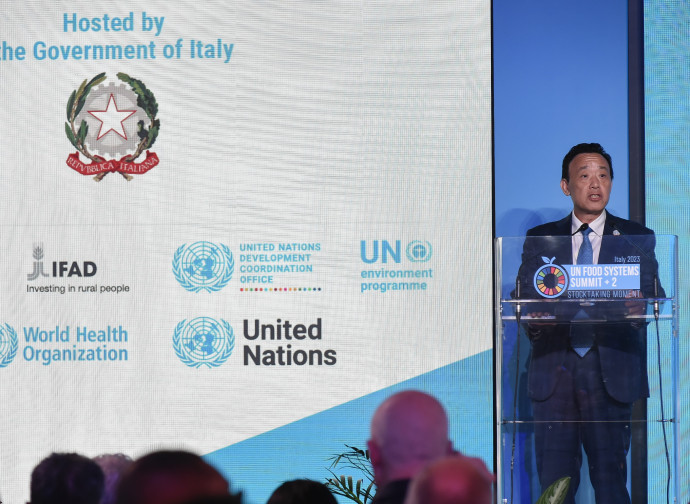2030 Agenda: Zero Hunger goal is a failure
In 2015, the UN officially declared war on malnutrition, and in the face of billions allocated, the situation has even worsened according to the 2024 Food Security Report. Funding is not enough if the causes are neglected.

Many believe that democracy cannot be exported if the cultural and social conditions that made its adoption possible in particular countries are lacking. It must be the effect of an internal process that takes place either through the initiative of political leadership or as a result of demands expressed from below. Only then does the support of the international community become useful. Glaring cases of failure are cited, for example that of Afghanistan. On the other hand, no one doubts that food security can be “exported” and therefore that the international community should do so by continuing to implement, as it has done for decades, food and agricultural programs entrusted to UN agencies, nongovernmental organizations and bilateral cooperation.
The second of the 17 Sustainable Development Goals of the U.N. 2030 Agenda presented in 2015-a colossal, highly ambitious program for the realization of which billions of dollars are being invested-targets to end hunger and malnutrition worldwide by 2030.
We are now only six years away from the completion of the UN 2030 Agenda. If not all, certainly many goals will not be met, and this raises serious questions about the effectiveness of the methods designed to achieve them. A report just released by the United Nations even reveals the total failure of the second goal, Zero Hunger. It is the 2024 Report on the State of Food Security and Nutrition in the World, compiled by five U.N. agencies-Fao (U.N. Food and Agriculture Organization), Ifad (International Fund for Agricultural Development), Unicef (U.N. Children's Fund), Wfp/WFP (World Food Program) and Who (World Health Organization, WHO the Italian acronym).
The report indicates that in 2023 between 717 and 757 million people, out of a total of eight billion, suffered from hunger, one in every 11 globally, one in every five in Africa, the continent most affected. Even greater is the number of people-864 million-who have not had access to adequate food, an expression by which is meant a state of “severe food insufficiency sometimes involving being without food for a whole day or more.” Adding people who have suffered moderate food insecurity, that is, who live in constant uncertainty of being able to obtain sufficient food and are forced during the course of the year to reduce the quantity and quality of their food at certain times, the number rises to 2.33 billion, or 28.9 percent of the world's population. Finally, when the quality of food is also taken into account, thus malnutrition, it turns out that more than a third of the planet's inhabitants, 2.8 billion, have found themselves in this situation.
“Although we have made some progress,” the report's authors comment, ”the progress has been uneven and insufficient. We have seen improvements in the most populous countries with growing economies, but hunger, food insecurity and malnutrition continue to increase in many countries around the world. It affects millions of people especially in rural areas where extreme poverty and food insecurity remain deeply entrenched. If trends noted so far persist, millions of people will still be undernourished by 2030.” In reality it will be hundreds of millions of people, some 582 million according to UN projections, half of them Africans and mostly, then as now, women and children.
The severity of the problem is made even more evident when looking at trends in recent years. In 2023, compared to 2022, the problem of hunger worsened in West Asia, the Caribbean, and especially in Africa where the population afflicted by hunger increased by 20.4 percent. Going back in time, the alarming fact is that in the past three years, the total number of hungry people has not decreased despite lavish efforts and substantial investments. But compared to 2015, the year when the Zero Hunger goal was included in the UN 2030 Agenda, the situation is even markedly worse. In 2015, there were 570.2 million undernourished people, or 7.7 percent of the world's population; by 2023, assuming the average figure of 733 million people, it was 9.1 percent. The largest increase, truly dramatic, was in Africa: from 192.1 million in 2015 to 298.4 million. In percentage terms and in comparison with the entire planet: in 2015, 16.0% of Africans while the global rate was 7.7%; in 2023, 20.4% and 9.1%, respectively.
In the face of such severely negative situations, all attention should go to the causes, country by country: wars, as in Sudan, Somalia, South Sudan, and Yemen, which together with the persecution of ethnic and religious minorities in many countries have brought the number of refugees, displaced persons and refugees, to more than 117 million; corruption and bad governance that deprive hundreds of millions of people of assistance, prevent human development, and leave immense territories and those who live there at the mercy of adverse weather phenomena...
One after another, in presenting their report, the directors of the five UN agencies instead emphasized the need for additional funding. Qu Dongyu, director-general of FAO, and Cindy McCain, executive director of WFP, on behalf of all appealed to the wealthiest G20 countries; Alvaro Lario, president of Ifad, urged more investment and global financial reform to channel new resources and less burdensome funding to the countries that need it most; Catherine Russell, executive director of UNICEF, and Tedros Adhanom Ghebreyesus, director-general of WHO, called for an urgent increase in funding.




